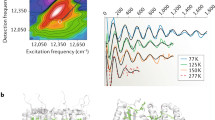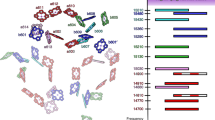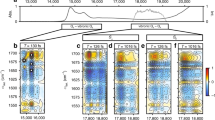Abstract
The idea that excitonic (electronic) coherences are of fundamental importance to natural photosynthesis gained popularity when slowly dephasing quantum beats (QBs) were observed in the two-dimensional electronic spectra of the Fenna–Matthews–Olson (FMO) complex at 77 K. These were assigned to superpositions of excitonic states, a controversial interpretation, as the strong chromophore–environment interactions in the complex suggest fast dephasing. Although it has been pointed out that vibrational motion produces similar spectral signatures, a concrete assignment of these oscillatory signals to distinct physical processes is still lacking. Here we revisit the coherence dynamics of the FMO complex using polarization-controlled two-dimensional electronic spectroscopy, supported by theoretical modelling. We show that the long-lived QBs are exclusively vibrational in origin, whereas the dephasing of the electronic coherences is completed within 240 fs even at 77 K. We further find that specific vibrational coherences are produced via vibronically coupled excited states. The presence of such states suggests that vibronic coupling is relevant for photosynthetic energy transfer.
This is a preview of subscription content, access via your institution
Access options
Access Nature and 54 other Nature Portfolio journals
Get Nature+, our best-value online-access subscription
$29.99 / 30 days
cancel any time
Subscribe to this journal
Receive 12 print issues and online access
$259.00 per year
only $21.58 per issue
Buy this article
- Purchase on Springer Link
- Instant access to full article PDF
Prices may be subject to local taxes which are calculated during checkout




Similar content being viewed by others
References
Cogdell, R. J., Gall, A. & Köhler, J. The architecture and function of the light-harvesting apparatus of purple bacteria: from single molecules to in vivo membranes. Q. Rev. Biophys. 39, 227–324 (2006).
Scholes, G. D., Fleming, G. R., Olaya-Castro, A. & van Grondelle, R. Lessons from nature about solar light harvesting. Nat. Chem. 3, 763–774 (2011).
Fenna, R. E. & Matthews, B. W. Chlorophyll arrangement in a bacteriochlorophyll protein from Chlorobium limicola. Nature 258, 573–577 (1975).
Hauska, G., Schoedl, T., Remigy, H. & Tsiotis, G. The reaction center of green sulfur bacteria. Biochim. Biophys. Acta Bioenerg. 1507, 260–277 (2001).
Dostál, J., Pšenčík, J. & Zigmantas, D. In situ mapping of the energy flow through the entire photosynthetic apparatus. Nat. Chem. 8, 705–710 (2016).
Tronrud, D. E., Wen, J., Gay, L. & Blankenship, R. E. The structural basis for the difference in absorbance spectra for the FMO antenna protein from various green sulfur bacteria. Photosynth. Res. 100, 79–87 (2009).
Ben-Shem, A., Frolow, F. & Nelson, N. Evolution of photosystem I—from symmetry through pseudosymmetry to asymmetry. FEBS Lett. 564, 274–280 (2004).
Vulto, S. I. E. et al. Exciton simulations of optical spectra of the FMO complex from the green sulfur bacterium Chlorobium tepidum at 6 K. J. Phys. Chem. B 102, 9577–9582 (1998).
Brixner, T. et al. Two-dimensional spectroscopy of electronic couplings in photosynthesis. Nature 434, 625–628 (2005).
Cho, M., Vaswani, H. M., Brixner, T., Stenger, J. & Fleming, G. R. Exciton analysis in 2D electronic spectroscopy. J. Phys. Chem. B 109, 10542–10556 (2005).
Adolphs, J. & Renger, T. How proteins trigger excitation energy transfer in the FMO complex of green sulfur bacteria. Biophys. J. 91, 2778–2797 (2006).
Savikhin, S. & Struve, W. S. Ultrafast energy transfer in FMO trimers from the green bacterium Chlorobium tepidum. Biokhimiya 33, 11200–11208 (1994).
Savikhin, S., Buck, D. R. & Struve, W. S. Toward level-to-level energy transfers in photosynthesis: the Fenna–Matthews–Olson protein. J. Phys. Chem. B 102, 5556–5565 (1998).
Hybl, J. D., Albrecht, A. W., Gallagher Faeder, S. M. & Jonas, D. M. Two-dimensional electronic spectroscopy. Chem. Phys. Lett. 297, 307–313 (1998).
Jonas, D. M. Two-dimensional femtosecond spectroscopy. Annu. Rev. Phys. Chem. 54, 425–463 (2003).
Thyrhaug, E., Žídek, K., Dostál, J., Bína, D. & Zigmantas, D. Exciton structure and energy transfer in the Fenna–Matthews–Olson complex. J. Phys. Chem. Lett. 7, 1653–1660 (2016).
Vulto, S. I. E. et al. Excited state dynamics in FMO antenna complexes from photosynthetic green sulfur bacteria: a kinetic model. J. Phys. Chem. B 103, 8153–8161 (1999).
Engel, G. S. et al. Evidence for wavelike energy transfer through quantum coherence in photosynthetic systems. Nature 446, 782–786 (2007).
Panitchayangkoon, G. et al. Long-lived quantum coherence in photosynthetic complexes at physiological temperature. Proc. Natl. Acad. Sci. USA 107, 12766–12770 (2010).
Savikhin, S., Buck, D. R. & Struve, W. S. Oscillating anisotropies in a bacteriochlorophyll protein: evidence for quantum beating between exciton levels. Chem. Phys. 223, 303–312 (1997).
Collini, E. et al. Coherently wired light-harvesting in photosynthetic marine algae at ambient temperature. Nature 463, 644–647 (2010).
Schlau-Cohen, G. S. et al. Elucidation of the timescales and origins of quantum electronic coherence in LHCII. Nat. Chem. 4, 389–395 (2012).
Harel, E. & Engel, G. S. Quantum coherence spectroscopy reveals complex dynamics in bacterial light-harvesting complex 2 (LH2). Proc. Natl. Acad. Sci. USA 109, 706–711 (2012).
Wendling, M. et al. Electron-vibrational coupling in the Fenna–Matthews–Olson complex of Prosthecochloris aestuarii determined by temperature-dependent absorption and fluorescence line-narrowing measurements. J. Phys. Chem. B 104, 5825–5831 (2000).
Lee, H., Cheng, Y.-C. & Fleming, G. R. Coherence dynamics in photosynthesis: protein protection of excitonic coherence. Science 316, 1462–1465 (2007).
Olbrich, C., Strumpfer, J., Schulten, K. & Kleinekathofer, U. Quest for spatially correlated fluctuations in the FMO light-harvesting complex. J. Phys. Chem. B 115, 758–764 (2011).
Shim, S., Rebentrost, P., Valleau, S. & Aspuru-Guzik, A. Atomistic study of the long-lived quantum coherences in the Fenna–Matthews–Olson complex. Biophys. J. 102, 649–660 (2012).
Maiuri, M., Ostroumov, E. E., Saer, R. G., Blankenship, R. E. & Scholes, G. D. Coherent wavepackets in the Fenna–Matthews–Olson complex are robust to excitonic-structure perturbations caused by mutagenesis. Nat. Chem. 10, 177–183 (2018).
Rätsep, M. & Freiberg, A. Electronphonon and vibronic couplings in the FMO bacteriochlorophyll a antenna complex studied by difference fluorescence line narrowing. J. Lumin. 127, 251–259 (2007).
Rätsep, M., Cai, Z.-l, Reimers, J. R. & Freiberg, A. Demonstration and interpretation of significant asymmetry in the low-resolution and high-resolution Qy fluorescence and absorption spectra of bacteriochlorophyll a. J. Chem. Phys. 134, 024506 (2011).
Ceccarelli, M., Lutz, M. & Marchi, M. A density functional normal mode calculation of a bacteriochlorophyll a derivative. J. Am. Chem. Soc. 122, 3532–3533 (2000).
Christensson, N., Kauffmann, H. F., Pullerits, T. & Mančal, T. Origin of long-lived coherences in light-harvesting complexes. J. Phys. Chem. B 116, 7449–7454 (2012).
Tiwari, V., Peters, W. K. & Jonas, D. M. Electronic resonance with anticorrelated pigment vibrations drives photosynthetic energy transfer outside the adiabatic framework. Proc. Natl. Acad. Sci. USA 110, 1203–1208 (2013).
Tempelaar, R., Jansen, T. L. C. & Knoester, J. Vibrational beatings conceal evidence of electronic coherence in the FMO light-harvesting complex. J. Phys. Chem. B 118, 12865–12872 (2014).
Augulis, R. & Zigmantas, D. Two-dimensional electronic spectroscopy with double modulation lock-in detection: enhancement of sensitivity and noise resistance. Opt. Express 19, 13126–13133 (2011).
Fuller, F. D. et al. Vibronic coherence in oxygenic photosynthesis. Nat. Chem. 6, 706–711 (2014).
Romero, E. et al. Quantum coherence in photosynthesis for efficient solar-energy conversion. Nat. Phys. 10, 676–682 (2014).
Hochstrasser, R. M. Two-dimensional IR-spectroscopy: polarization anisotropy effects. Chem. Phys. 266, 273–284 (2001).
Zanni, M. T., Ge, N.-H., Kim, Y. S. & Hochstrasser, R. M. Two-dimensional IR spectroscopy can be designed to eliminate the diagonal peaks and expose only the crosspeaks needed for structure determination. Proc. Natl. Acad. Sci. USA 98, 11265–11270 (2001).
Westenhoff, S., Palecek, D., Edlund, P., Smith, P. & Zigmantas, D. Coherent picosecond exciton dynamics in a photosynthetic reaction center. J. Am. Chem. Soc. 134, 16484–16487 (2012).
Paleček, D., Edlund, P., Westenhoff, S. & Zigmantas, D. Quantum coherence as a witness of vibronically hot energy transfer in bacterial reaction center. Sci. Adv. 3, e1603141 (2017).
Duan, H.-G. et al. Nature does not rely on long-lived electronic quantum coherence for photosynthetic energy transfer. Proc. Natl. Acad. Sci. USA 114, 8493–8498 (2017).
Li, H., Bristow, A. D., Siemens, M. E., Moody, G. & Cundiff, S. T. Unraveling quantum pathways using optical 3D Fourier-transform spectroscopy. Nat. Commun. 4, 1390 (2013).
Seibt, J., Hansen, T. & Pullerits, T. 3D spectroscopy of vibrational coherences in quantum dots: theory. J. Phys. Chem. B 117, 11124–11133 (2013).
Butkus, V. et al. Discrimination of diverse coherences allows identification of electronic transitions of a molecular nanoring. J. Phys. Chem. Lett. 8, 2344–2349 (2017).
Thyrhaug, E. et al. Ultrafast coherence transfer in DNA-templated silver nanoclusters. Nat. Commun. 8, 15577 (2017).
Fransted, K., Caram, J. R., Hayes, D. & Engel, G. S. Two-dimensional electronic spectroscopy of bacteriochlorophyll a in solution: elucidating the coherence dynamics of the Fenna–Matthews–Olson complex using its chromophore as a control. J. Chem. Phys. 137, 125101 (2012).
Mukamel, S Principles of Nonlinear Optical Spectroscopy (Oxford Univ. Press, Oxford, 1995).
Butkus, V., Zigmantas, D., Valkunas, L. & Abramavicius, D. Vibrational vs. electronic coherences in 2D spectrum of molecular systems. Chem. Phys. Lett. 545, 40–43 (2012).
Orlandi, G. & Siebrand, W. Theory of vibronic intensity borrowing. Comparison of Herzberg–Teller and Born–Oppenheimer coupling. J. Chem. Phys. 58, 4513–4523 (1973).
Dostál, J., Mančal, T., Vácha, F., Pšenčík, J. & Zigmantas, D. Unraveling the nature of coherent beatings in chlorosomes. J. Chem. Phys. 140, 115103 (2014).
Kano, H., Saito, T. & Kobayashi, T. Observation of Herzberg–Teller-type wave packet motion in porphyrin J-aggregates studied by sub-5-fs spectroscopy. J. Phys. Chem. A 106, 3445–3453 (2002).
Dostál, J., Mančal, T., Vácha, F., Pšenčík, J. & Zigmantas, D. Unraveling the nature of coherent beatings in chlorosomes. J. Chem. Phys. 140, 115103 (2014).
Wen, J., Zhang, H., Gross, M. L. & Blankenship, R. E. Membrane orientation of the FMO antenna protein from Chlorobaculum tepidum as determined by mass spectrometry-based footprinting. Proc. Natl Acad. Sci. USA 106, 6134–6139 (2009).
Wahlund, T. M., Woese, C. R., Castenholz, R. W. & Madigan, M. T. A thermophilic green sulfur bacterium from New Zealand hot springs, Chlorobium tepidum sp. nov. Arch. Microbiol. 156, 81–90 (1991).
Holstein, T. Studies of polaron motion. Ann. Phys. 8, 325–342 (1959).
Olbrich, C. et al. From atomistic modeling to excitation transfer and two-dimensional spectra of the FMO light-harvesting complex. J. Phys. Chem. B 115, 8609–8621 (2011).
Jansen, T. L. C. & Knoester, J. Nonadiabatic effects in the two-dimensional infrared spectra of peptides: application to alanine dipeptide. J. Phys. Chem. B 110, 22910–22916 (2006).
Torii, H. Effects of intermolecular vibrational coupling and liquid dynamics on the polarized Raman and two-dimensional infrared spectral profiles of liquid N,N-dimethylformamide analyzed with a time-domain computational method. J. Phys. Chem. A 110, 4822–4832 (2006).
Acknowledgements
The work in Lund was supported by the Swedish Research Council, the Knut and Alice Wallenberg Foundation and the Crafoord Foundation. R.T. acknowledges The Netherlands Organisation for Scientific Research (NWO) for support through a Rubicon grant. D.B. acknowledges funding from Czech Science Foundation under grant no. P501/12/G055 and institutional support RVO:60077344. We thank D. Paleček for making available his code for complex QB analysis.
Author information
Authors and Affiliations
Contributions
D.Z. conceived the idea, E.T., M.J.P.A., K.Z. and D.Z. designed and performed experiments, R.T., J.K. and T.L.C.J. designed the theory, R.T. performed simulations and D.B. extracted and purified the sample. E.T., M.J.P.A. and R.T. analysed the data. E.T., R.T. and D.Z. wrote the manuscript with input from all the other authors.
Corresponding author
Ethics declarations
Competing interests
The authors declare no competing financial interests.
Additional information
Publisher’s note: Springer Nature remains neutral with regard to jurisdictional claims in published maps and institutional affiliations.
Supplementary information
Supplementary Information
Supplementary Figures 1–5, Supplementary Table 1, Supplementary Data and Methods
Rights and permissions
About this article
Cite this article
Thyrhaug, E., Tempelaar, R., Alcocer, M.J.P. et al. Identification and characterization of diverse coherences in the Fenna–Matthews–Olson complex. Nature Chem 10, 780–786 (2018). https://doi.org/10.1038/s41557-018-0060-5
Received:
Accepted:
Published:
Issue Date:
DOI: https://doi.org/10.1038/s41557-018-0060-5
This article is cited by
-
Simulating photosynthetic energy transport on a photonic network
npj Quantum Information (2024)
-
Quantum phase synchronization via exciton-vibrational energy dissipation sustains long-lived coherence in photosynthetic antennas
Nature Communications (2024)
-
Single-photon absorption and emission from a natural photosynthetic complex
Nature (2023)
-
Recent progress in atomistic modeling of light-harvesting complexes: a mini review
Photosynthesis Research (2023)
-
Wavelike electronic energy transfer in donor–acceptor molecular systems through quantum coherence
Nature Nanotechnology (2022)



